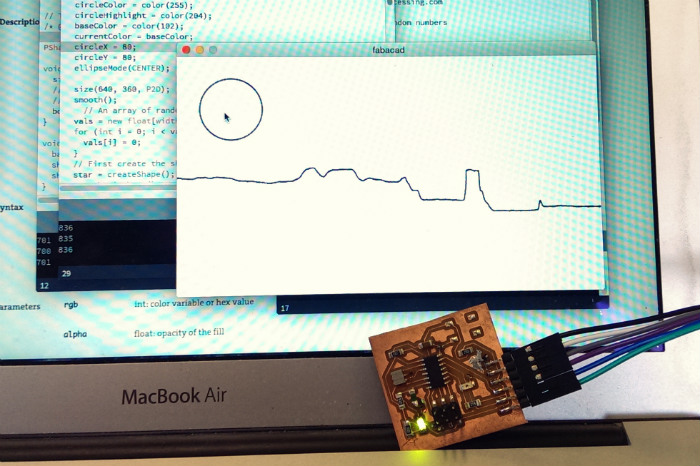
13 Interface and Application Programming
Processing
I chose to use processing this week as I had never used it before and am curious about it's similatities to the Arduino IDE.
Much like with most Arduino projects I started by playing with a few example sketches. I ended up hacking together parts from the built in serial SimpleRead example and this example for plotting a graph. With those two I was able to get a simple live graph running that would display light levels from my board over time onvce the arduino was setup.

Arduino Setup
I setup my input/output board to continuously read light levels from the photo trnsistor and send the reading out on the serial port. I also porgrammed it to listen to the serial port and turn on the boards led on or of depending it a '1' or '0' is recieved on the serial port input. (The full code is at the end of this post)
void loop()
{
lightValue = analogRead(sensorLight);
mySerial.println(lightValue);
if (mySerial.available())
{ // If data is available to read,
val = mySerial.read(); // read it and store it in val
}
if (val == '1')
{ // If 1 was received
digitalWrite(ledPin, HIGH); // turn the LED on
} else {
digitalWrite(ledPin, LOW); // otherwise turn it off
}
delay(30); // Wait 30 milliseconds for next reading
}
And then used parts of this example for adding in a button that could trigger the sending of a '1' or '0' to the board. (The full code is at the end of this post.)
 At this point I had a funtioning GUI that could display input from the board and send output to control the board!
At this point I had a funtioning GUI that could display input from the board and send output to control the board!
Processing code
import processing.serial.*;
Serial myPort; // Create object from Serial class
String val; // Data received from the serial port
float[] vals; // Array for previous data
int circleX, circleY; // Position of circle button
int circleSize = 93; // Diameter of circle
color circleColor, baseColor;
color currentColor;
boolean circleOver = false;
boolean LedOn = false;
void setup()
{
circleColor = color(255);
baseColor = color(102);
currentColor = baseColor;
circleX = 80;
circleY = 80;
ellipseMode(CENTER);
size(640, 360, P2D);
smooth();
// An array of random values
vals = new float[width];
for (int i = 0; i < vals.length; i++) {
vals[i] = 0;
}
String portName = Serial.list()[2]; //change the 0 to a 1 or 2 etc. to match your port
myPort = new Serial(this, portName, 9600);
background(255);
}
void draw()
{
update(mouseX, mouseY);
//background(255);
stroke(255);
int valint =0;
if ( myPort.available() > 0)
{ // If data is available,
val = myPort.readStringUntil('\n'); // read it and store it in val
//println(val);
if(val != null)
{
val = trim(val);
valint = Integer.parseInt(val);
println(valint); //print it out in the console
background(255);
// Draw lines connecting all points
for (int i = 0; i < vals.length-1; i++) {
stroke(0);
strokeWeight(2);
line(i,vals[i],i+1,vals[i+1]);
}
stroke(0);
//Draw out button
ellipse(circleX, circleY, circleSize, circleSize);
// Slide everything down in the array
for (int i = 0; i < vals.length-1; i++) {
vals[i] = vals[i+1];
}
// Add a new value
vals[vals.length-1] = valint/2.5 - 100;
}
}
}
void update(int x, int y) {
if ( overCircle(circleX, circleY, circleSize) ) {
circleOver = true;
} else {
circleOver = false;
}
}
void mousePressed() {
if (circleOver) {
if (LedOn == true)
{ //if we clicked in the window
myPort.write('1'); //send a 1
println("1");
LedOn = false;
} else
{ //otherwise
myPort.write('0'); //send a 0
LedOn = true;
}
}
}
boolean overCircle(int x, int y, int diameter) {
float disX = x - mouseX;
float disY = y - mouseY;
if (sqrt(sq(disX) + sq(disY)) < diameter/2 ) {
return true;
} else {
return false;
}
}
Arduino Code
#include <SoftwareSerial.h>
SoftwareSerial mySerial(0, 1); // RX, TX
//int sensorTemp = A7; // select the input pin for the potentiometer
int sensorLight = A3; // select the input pin for the potentiometer
int ledPin = 8; // select the pin for the LED
int tempValue = 0; // variable to store the value coming from the sensor
int lightValue = 0; // variable to store the value coming from the sensor
char val; // Data received from the serial port
void setup()
{
// set the data rate for the SoftwareSerial port
mySerial.begin(9600);
mySerial.println("Hello, world?");
pinMode(ledPin, OUTPUT);
}
void loop() // run over and over
{
lightValue = analogRead(sensorLight);
mySerial.println(lightValue);
if (mySerial.available())
{ // If data is available to read,
val = mySerial.read(); // read it and store it in val
}
if (val == '1')
{ // If 1 was received
digitalWrite(ledPin, HIGH); // turn the LED on
} else {
digitalWrite(ledPin, LOW); // otherwise turn it off
}
delay(30); // Wait 30 milliseconds for next reading
}